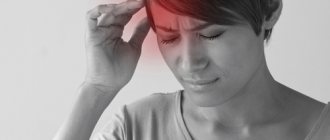Publication date: June 18, 2019
Very often, the cause of headaches (cephalalgia) is lability of blood pressure, which is why such pains are also called “vascular.” Treatment of vascular headache should always begin with eliminating the cause, that is, normalizing the pressure if it provokes the appearance of this symptom. A typical picture of the pathology will look like throbbing or tingling pain, sometimes even a burning sensation.
In a number of cephalgia, headaches with normal pressure are also often encountered, the treatment of which can be very different from vascular headaches. Often such pain occurs against the background of other pathologies and is only a sign, not a disease. The pain mechanism is triggered by the direct impact of various processes on the sensitive receptors of the dura mater and cranial tissue. When cephalalgia appears, it is always worth determining its cause.
The following factors can cause headaches against the background of normal blood pressure:
- traumatic brain injury;
- inflammatory processes both in the head and in other parts of the body (sinusitis, otitis, mastoiditis, etc.);
- neuralgia of the facial trigeminal nerve (usually only part of the head hurts, paroxysmal, tingling);
- brain abscess (temples, frontal part hurt);
- pregnancy;
- flu, colds, adenoviral infection;
- pituitary adenoma;
- frequent stress;
- allergy;
- fistula;
- PMS in women;
- vertebral artery syndrome;
- excessive mental stress (tension cephalgia);
- general fatigue.
All these reasons require a different medical approach, so treatment of headaches with normal blood pressure consists of identifying the factor that caused it and selecting adequate therapy. Sometimes a Paracetamol or Ibuprofen tablet is enough, sometimes normal sleep and rest, in other cases the mandatory help of specialists is required.
Types of headaches
The International Headache Society proposes to distinguish the following types of headaches:
- Primary headaches, when it is not possible to identify the organic cause of pain - they account for 95–98% of headache cases
- Secondary headaches associated with organic lesions of the brain or other organs
- Cranial (cranial) neuralgia, central and primary facial pain, as well as other headaches
The most common types of headaches encountered in practice are:
- Migraine
- Tension headache (TTH)
- Cluster headache (PHB)
- Overuse headache (medication overuse headache, AHA)
Migraine is an episodic form of primary headache, which manifests itself as intense paroxysmal, often unilateral, headaches, in combination with various neurological, autonomic, and gastrointestinal manifestations. Migraine pain is severe, throbbing and pressing in nature, usually spreading to half of the head. Before an attack, there may be warning signs such as weakness, difficulty concentrating, and increased sensitivity to sound, light, and smells. During the attack itself, these manifestations may be accompanied by nausea, vomiting, dizziness, fainting, increased heart rate, suffocation and other vegetative symptoms. There are also manifestations attributed to migraine aura - patients see flashes, flies, flickering or luminous objects, note unilateral loss of the visual field, unilateral weakness in the limbs, transient speech disorders.
Tension headache from the group of primary headaches manifests itself as a bilateral headache of a compressive or pressing nature of mild or moderate intensity, lasting from several minutes to several days. The pain spreads over the head in the form of a “hoop” and is rarely accompanied by nausea, sensitivity to light or sound. Often headaches are accompanied by pain in the back of the head, neck and shoulders.
Cluster headache is a form of primary headache with attacks of very intense, strictly unilateral pain in the temporal region, around the eye, or mixed localization. The duration of attacks is from 15 minutes to 3 hours, attacks are repeated every 2 days or more often and are grouped in series in time (“clusters” or “bundles”). In this case, on the pain side, symptoms such as lacrimation, redness of the eye, nasal congestion and rhinorrhea, sweating of the forehead and face, drooping eyelid, and constriction of the pupil appear. The pain is very pronounced, sometimes unbearable so much that motor restlessness, aggression occur, and suicide attempts have been described.
Drug-induced, or abuse, headache from the group of secondary headaches is of a bilateral pressing nature and has insignificant or moderate intensity. An important criterion: it lasts more than 15 days per month in a patient who has been taking medications for more than 3 months (at least two weeks each month). Potentially dangerous drugs for headaches from excessive drug use include analgesics, NSAIDs and their combinations, triptans, ergotamine derivatives, opioids - those drugs that are used to treat other types of headache. Taking medications that are already effective against abusive headaches provides incomplete relief and forces you to continue taking them.
Treatment of headaches with high blood pressure
Treatment of headaches with high blood pressure is resorted to when diastolic pressure figures rise above 120 mmHg, or there is a sharp jump in blood pressure (pressure rises by 25% of the normal value and above). If there are problems with blood vessels, the headache will have a bursting, pulsating character, localized in the temples and back of the head. With nervous and physical stress, cephalalgia slowly increases and also subsides, and may be accompanied by nausea and dizziness. A sharp jump in blood pressure causes a severe bursting headache, which intensifies with any movement. With spasm of the cerebral arteries, the patient complains of “floaters before the eyes” and a dull pain in the head.
Treatment of headaches with high blood pressure always begins with measuring blood pressure. If the numbers are elevated, you should first bring the blood pressure back to normal, and then eliminate the headache with other drugs if it does not go away.
To normalize high blood pressure, the following means are used:
- calcium channel blockers - Cordafen, Nifedipine, Verapamil, Phenigidine, Corinfar, Felodipine;
- a new generation of selective beta blockers (reduce heart rate) - Metoprolol, Tenoric, Bisoprolol, Egilok;
- myotropic antispasmodics (prescribed at the beginning of the development of hypertension) - No-shpa, Dibazol, Magnesium sulfate, Papazol, Spazmalgon;
- diuretics (reduce blood pressure by reducing blood volume by removing water from the body with urine) - Lasix, Furosemide, Trifas;
- sartans (without affecting the heart, they reduce blood pressure) - Candesartan, Eprosartan, Irbesartan, Telmisartan;
- ACE inhibitors (dilate blood vessels, reduce blood pressure well) - Renitec, Enam, Captopril, Enalapril, Ramipril, Trandolapril;
- nitrates (sharply reduce blood pressure, used mainly for angina pectoris, myocardial infarction) - Cardiket, Sustak, Perlinganite, Erinit, Isoket;
- ganglion blockers (eliminate spasms in arterioles) - Phentolamine, Benzohexonium, Ebrantil.
If you don’t know how to relieve a headache with high blood pressure, when it has already returned to normal, then you can choose a drug from the list below, but you should first consult with your doctor.
The following will help you get rid of this cephalalgia:
- Ascopar;
- Acetylsalicylic acid;
- Has;
- Paracetamol;
- Solpadeine;
- Citramon.
When taking these medications, you should keep in mind that they should not be taken for more than 10-15 days in a row.
The text was checked by expert doctors: Head of the socio-psychological service of the Alkoklinik MC, psychologist Yu.P. Baranova, L.A. Serova, a psychiatrist-narcologist.
CAN'T FIND THE ANSWER?
Consult a specialist
Or call: +7 (495) 798-30-80
Call! We work around the clock!
The first table excludes
Thus, it is important for the pharmacist to exclude hypertension, which requires mandatory consultation with a doctor. To do this, you need to ask a few questions.
- Questions about the nature of GB:
- What is the intensity of headache, its nature and localization?
- Are there any accompanying symptoms?
- What causes headache attacks?
- Questions about HD treatment:
- What medications for migraines and headaches has the patient already used or is currently using?
- With what effect?
- Presence of warning symptoms requiring mandatory medical attention:
- Intense headache with a sudden (“explosive”) onset can develop with subarachnoid hemorrhage.
- Headache with an atypical aura lasting more than an hour or motor weakness is characteristic of a cerebrovascular accident - transient ischemic attack or stroke, as well as the presence of an aura without headache, although there was previously migraine with aura.
- An aura that first appears in a patient taking combined oral contraceptives may indicate a risk of stroke.
- Increasing headache that gets worse over several weeks or more, or headache that gets worse with changes in posture, coughing, sneezing, or straining, may indicate the presence of a space-occupying intracranial formation.
- Also requires consultation with a neurologist in headaches accompanied by focal neurological symptoms (shaky gait, unilateral and bilateral paralysis, etc.), and headaches with fever of unknown origin.
- A previous fall or head injury is a reason to see a doctor to rule out a TBI.
The presence of an intense headache, spreading to half of the head, accompanied by nausea, vomiting, sensitivity to light and sound, or a typical aura, may indicate a migraine. Severe (even unbearable) unilateral pain in the temple, orbit, or mixed localization, accompanied by a feeling of anxiety and/or autonomic symptoms on the side of pain, indicates the presence of cluster headache. In both cases, the pain syndrome is poorly controlled by conventional analgesics and requires the prescription of specific therapy by a doctor. Headache accompanied by severe pain in the eyes and blurred vision requires exclusion of glaucoma.
Long-term previous use of analgesics allows one to suspect the development of excessive hypertension, which also requires consultation with a neurologist.
Headache due to arterial hypertension
Arterial hypertension or hypertension (constantly high blood pressure) is one of the important etiological factors in the formation of headaches.
For a long time, this kind of cephalgia was classified as a vascular disease. Today, doctors are more inclined to attribute it to pathologies associated with disturbances of homeostasis (self-regulation, the body’s ability to constantly maintain a balance of internal state).
Arterial hypertension is a fairly common disease of the cardiovascular system, affecting approximately 20-30% of the entire adult population. In elderly and elderly people, the prevalence of the disease gradually increases and reaches 65%. Hereditary genetic factors play an important role in the occurrence of high blood pressure.
As a rule, hypertension is inherited or occurs as a result of intense psychological activity, frequent stress and the constant influence on the body of psycho-emotional factors that provoke disturbances in the brain regulation of the vasomotor system and/or hormonal mechanisms that control blood pressure. Headaches that appear against the background of hypertension require careful examination for their adequate treatment and parallel treatment of the underlying disease.
Mechanisms of headache
Today, doctors identify the following mechanisms that cause cephalalgia:
- pain associated with abnormalities of the vascular bed or pathologies of the cardiovascular system;
- pain caused by muscle strain or spasm;
- liquorodynamic disorders in the body;
- pain associated with neuralgic and/or mental disorders.
As statistics show, quite often the same patient experiences headaches from a combination of several of the above factors, and therapy only for arterial hypertension in the hope that the pain will go away on its own is often wrong.
Vascular factor
In turn, vascular headaches can be divided into:
- vasomotor (vegetative-vascular dystonia) with pronounced functional disorders of the tone of blood vessels, both arterial and venous;
- ischemic-hypoxic, in which organic changes in the walls of blood vessels are noted, such as in atherosclerosis or arterial hypertension.
Vasomotor manifestations of cephalgia, as a rule, are pulsating in nature, coinciding with the heart rhythm, radiating to the back of the head and temples, accompanied by tinnitus, dizziness, flashing spots in front of the eyes or diverging circles. At the same time, vasospasm itself (periodic narrowing of small arteries and capillaries) does not cause headaches in patients with mild to moderate systemic increases in blood pressure. It occurs in the event of a sharp increase in pressure, when the patient’s condition approaches a hypertensive crisis.
Ischemic headache is characterized by pressing, aching sensations, aching dull pain, accompanied by a feeling of “heaviness” in the head, distracted attention, lack of concentration, memory impairment, inability to concentrate, and blurred images. Such pain occurs against the background of progression of hypertensive discircular encephalopathy (brain damage) and is accompanied by cerebral circulation disorders, increased blood viscosity and changes in its rheological and aggregation properties.
The following contribute to ischemic cephalgia: vertebrobasilar vascular insufficiency, cervical osteochondrosis, muscle-tonic reactions of the neck and/or head. As a result of chronic compression of cerebral vessels, oxidative processes slow down (oxygen starvation), energy deficiency occurs and a number of pathological reactions develop, which provoke necrosis (death) of neurons.
Venous type headaches are caused by dysfunctions of the venous part of the circulatory system (its insufficiency or stagnation). May be accompanied by respiratory diseases and increased intrathoracic pressure.
As a rule, venous outflow of blood occurs in an upright position of the body, so such cephalgia occurs or intensifies after a long stay in a lying position (morning headaches), sitting with a low head, or when the chest is tense during a chronic cough.
Associated symptoms: “heaviness” of the head, dilation of the fundus veins, swelling of the face and eyelids, localization of pain in the occipital part of the head, at the projection site where the intracranial venous sinuses merge.
Muscle tension pain due to hypertension
This pathology is based on spasm and pain syndrome of muscle tissue, caused by two parallel or independent processes:
- Overstrain of the muscle fibers themselves, stagnation of blood in them, swelling, inflammation, then a change in chemical reactions (an increase in the concentration of potassium, which stimulates chemoreceptors). Chemoreceptors, in turn, convert chemical indicators into nerve impulses (excitation) and transmit them to the central nervous system.
- Emotional overstrain, which provokes spasm of muscle fibers and difficulty in passing neuromuscular signals through them.
Muscle spasms contribute to the accumulation of lactic acid in the fibers, the development of ischemia and hypoxia, which significantly increases headaches. Considering that people with arterial hypertension quite often have neurasthenic or depressive tendencies and feel a lack of psychological protection, muscle factors are added to the vascular factors.
In addition, the development of the disease is adversely affected by the presence of osteochondrosis disorders, postural curvatures, muscular-tonic anomalies, dysfunction of the temporal and mandibular joints, and inadequate vision correction. Chronic hypertonicity or spasm of the cervical and shoulder muscles causes reflex overstrain of the muscles of the head and scalp.
Such pain is characterized by a moderate-intensity feeling of a “hoop” or “hat” placed on the head, localized in the occipital-parietal or frontal lobes. The pain syndrome weakens with adequate physical activity, acupressure, muscle relaxation or massage and intensifies with emotional overstimulation. It is worth noting that quite often, when tension headaches are eliminated in patients with arterial hypertension, blood pressure normalizes.
Liquorodynamic pain
Liquorodynamic cephalalgia appears against the background of an increase or decrease in the production (production) of cerebrospinal fluid, as well as disturbances in its outflow due to any pathological processes. In patients suffering from hypertension, such headaches are associated with cerebral edema after a hypertensive crisis or exacerbation of encephalopathy. Quite often they are combined with venous stagnation of blood and venous pain.
Intracranial hypertension is characterized by bursting pain, accompanied by nausea, vomiting, dizziness, and with severe cerebral edema - confusion, disturbances in coherent speech, hearing and vision. The pain eases when the person takes an upright position or sleeps on a high pillow. Additional signs of pathology are: pain when pressing on the eyeballs, stagnation of venous blood in the fundus, swelling of the area and the optic nerve itself, hydrocephalus.
Such headaches are characterized by dull, low-intensity, but chronically generalized sensations, and when blood pressure increases, they become pulsating.
Neuralgic factors
Neurological headaches are the most specific of all of the above and belong to the category of prosopalgia (headaches of the facial area without a specific genesis). The nature of the manifestations is characterized by short bursts of shooting pain that occur one after another and the presence of trigger zones that give rise to paroxysm.
For example, with trigeminal facial neuralgia, an increase in blood pressure during a hypertensive crisis can cause neurological paroxysm. At the same time, the development of hypertensive discircular encephalopathy can cause neuralgia, ischemia or compression of the trigeminal nerve.
The psychogenic mechanisms of the occurrence of cephalgia are associated with anomalies of nociception that occur after hysterical or depressive syndromes, and neurosis-like conditions, in turn, are quite often present in arterial hypertension. The pain sensations vary for each patient and have their own specifics, but in any case they interfere with normal life and work.
Relationship between cerebral blood flow, hypertension and cephalalgia
It is worth noting again that chronically high blood pressure in most cases is not the direct cause of headaches. On the contrary, pain syndrome occurs after a sharp drop in blood pressure, when it is knocked down during a crisis.
Cerebral blood flow is also quite autonomous and practically does not depend on pressure changes; it begins to change slowly and passively only at critical levels (minimum - 50-60 mm Hg, maximum - more than 200). At the same time, normal functioning and functioning of the brain is possible only with a complete blood supply. Circulatory disorders cause cerebral ischemia and dysfunction.
The protective reaction of the brain to long-term hypertension is the development of compensatory hypertrophy of the muscular linings of blood vessels, which are able to restrain blood pressure and normalize cerebral circulation. This allows you to move the upper limit even higher and, as statistics show, hypertensive patients with a working pressure of 200 mm Hg. Art. practically do not complain of headaches.
Diagnostic algorithms for excluding secondary headaches in hypertension
In parallel with constantly elevated blood pressure, other diseases can develop, the manifestation of which is cephalalgia. To identify and exclude such situations, additional clinical studies are carried out:
- Anamnesis collection.
- Examination of the head (excluding manifestations of head injuries, cervical spine injuries, muscle spasms and inflammation, compactions in the tendons, changes in blood flow in the temporal and vertebral arteries).
- Examination of the neural network of the head and skull, exclusion of neuralgia and neuritis.
- Diagnosis of the organs of vision, fundus of the eye, exclusion of acute glaucoma.
- Examination of the oral cavity (exclusion of dental pathologies), palatine vaults, rhinitis and sinusitis cavities.
- Diagnosis of the functioning of the facial joints (temporal, mandibular, their range of motion, symmetry), checking the bite.
- Exclusion of osteochondrosis, pathologies of muscle tissue (spasm, congestion, inflammation), developmental anomalies of the cervical spine.
- Checking for postural disorders and asymmetries in the development of skeletal muscles, which can also cause headaches.
- Diagnosis of possible meningitis, subarachnoid hemorrhages, vascular blockages.
- Exclusion of tumor formations and metastases.
- Examination of the lymphatic system and nodes, thyroid gland, ears, lungs, heart and other internal organs.
- Rule out increased intracranial pressure.
Pain syndromes combined with arterial hypertension, which should alert patients:
- the occurrence of chronic pain in older age (over 50 years);
- a significant increase in habitual pain or a significant difference in their manifestations;
- the occurrence of night headaches;
- increased pain during physical effort or stress, sudden movements;
- a combination of pain with neurological abnormalities (confusion, consciousness, impaired coordination, weakened memory, dysfunction of the organs of vision, smell and hearing);
- the occurrence of nausea, vomiting, dizziness, especially in the morning;
- chronically elevated body temperature, fever, weight loss, prolonged cough or rhinitis.
Author: K.M.N., Academician of the Russian Academy of Medical Sciences M.A. Bobyr









